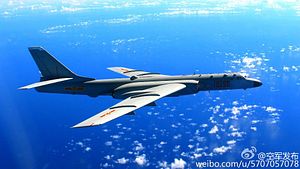The Chinese People’s Liberation Army Air Force (PLAAF) has flown a long-range bomber over a disputed feature in the South China Sea, according to images published by China’s State Council Information Office on July 15.
The pictures of a H-6K bomber flying over Scarborough Shoal, known as Huangyan Island in Chinese, first appeared on the PLAAF’s official Weibo microblog account. According to a statement by PLAAF Senior Colonel Shen Jinke on Weibo, quoted in The Wall Street Journal, the overflight was regular “practice” and part of the PLAAF’s more realistic combat training. There are currently around 16 H-6Ks in service with the PLAAF.
“To effectively fulfill its mission, the air force will continue to conduct combat patrols on a regular basis in the South China Sea,” Shen said. “The PLA Air Force will firmly defend national sovereignty, security, and maritime interests, safeguard regional peace and stability, and cope with various threats and challenges,” he added.
It remains unclear how many aircraft were involved in the flight over Scarborough Shoal , a feature 120 nautical miles off the coast of the Philippines’ Luzon Island.”The PLA sent H-6K bombers and other aircraft including fighters, scouts, and tankers to patrol islands and reefs including Huangyan Dao,” Xinhua news agency reported on July 18.
Chinese state television showed footage on July 18 that also included fourth-generation J-11BH/BHS fighter aircraft, according to The Wall Street Journal. In November 2015, China stationed an unknown number of J-11 fighter jets on Woody Island, the largest of the Paracel Islands occupied by China. It is also uncertain what exact route and how close to the shoal the PLAAF conducted the combat patrol.
Furthermore, the PLAAF has not clarified whether the flight took place before or after the July 12 ruling by The Hague-based Permanent Court of Arbitration (PCA) over maritime entitlements and the legal status of features claimed by both China and the Philippines in the South China Sea.
As I wrote elsewhere (See: “China’s Air Force Can Now Range Long-Range Precision Strikes”), the PLAAF’s H-6K long-range bomber is a derivative of the Soviet-era Tupolov Tu-16 twin-engined jet strategic bomber. In 2007, the PLAAF introduced the bomber’s latest variant with more powerful and fuel-efficient engines, lighter weight composites, and modern electronics, among a host of other upgrades.
The H-6K’s maximum range is about 1,900 miles (3,057 kilometers) and the bomber can carry a payload of up to 12 tons. “The H-6K, which lacks stealth capacity, can carry up to seven YJ-12 supersonic anti-ship missiles (six on wing pylons plus one in the bomb bay) or CJ-20 subsonic land-attack cruise missiles with an estimated range of 250 and 1,500 miles respectively,” I wrote in October 2015.(China is purportedly also working on a new strategic bomber design.)
In April, the United States dispatched A-10C Thunderbolt II aircraft and HH-60 Pave Hawk helicopters on air patrols near Scarborough Shoal. The U.S. Navy also deployed four EA-18G Growler airborne electronic attack aircraft on Luzon Island in the Philippines to support U.S. and Philippine naval operations in the South China Sea, including near Scarborough Shoal.






























